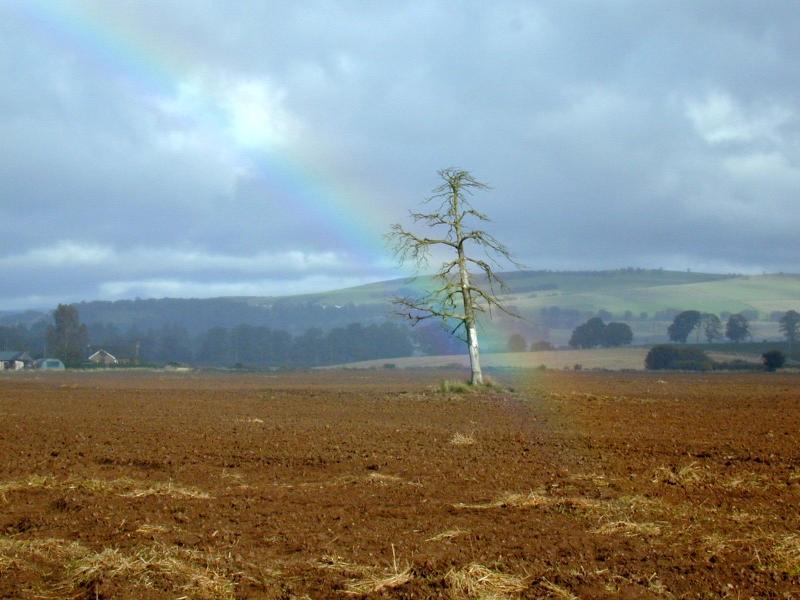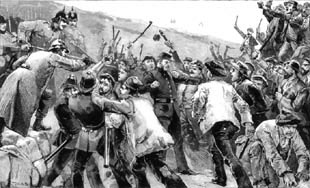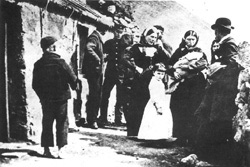
You've read how the Agricultural Revolution produced benefits for landlords and farmers alike. Subsistence farming gave way to profit-based agriculture intended to supply town dwellers and greatly improved farming methods increased crop production dramatically. Since the capital costs of the new equipment were high, and since the new ploughs, threshers, etc. were much more efficient, a single farmer could handle more land. A wave of farm amalgamations swept across the Lowlands. Farmers who could adapt to the new methods were given bigger farms and longer leases. Those who couldn't adapt were forced off their land. This period of time was dubbed the Lowland Clearances.
The landowner's justified their actions because, from their perspective, the traditional tenant class was idle and hidebound. Landowners felt that the lower the rent and the smaller the farm, the worse was the tenant. After all, any man of ingenuity and energy would not be interested in a small farm. Therefore, only exceptional tenants should be encouraged with favourable leases and it was the farmer who was able to learn the new methods who should be given the larger farms. Since leases were short in those times, landlords would wait for the expiry of the leases and then raise the rents to the point where the unwanted tenants finally surrendered their land voluntarily. Lowland landowners began to raise rents markedly from 1763, doubled them from 1783, and doubled them again from 1794 to 1815.
If rent increases didn't work, tenants were given deeds that required them to plant their fields in a certain way and/or grow certain crops. If they didn't obey, they'd be given a stay of execution for perhaps a year, and then they'd lose their land. Only tenants who adopted the new farming ways were allowed to stay.


Above, images from the Highland Clearances when highland Scots were forcibly removed from their lands.
Scotland was a hierarchical society. Landlords, with their hereditary-derived powers, were able to use their historical legal muscles with impunity. Unlike the Highland Clearances which followed, (see pictures above), no force was ever used in the Lowland Clearances and no hue and cry ensured. In fact, again from the perspective of the ruling class, what the landowners were doing was beneficial not only to the country but to the peasant as well. Here's a comment from the times.
It must occur to every person who travels through the county and is at any pains to make observations, that where the farms are large the tenantry live better, clothe better and are more comfortable in every respect than when the farms were small. About half a century ago the farmer went on foot to market; now he rides properly accoutred in every point; formerly he ate his food off his knee and it consisted of meal, vegetable or milk; now his table is covered, his knife and fork are laid down before him to dine on meat; his father lay on a straw bed without curtains, he sleeps on feathers with his curtains drawn round him. Servants and labourers have advanced in the same proportion in their desire for the comforts of life. Since they are more industrious than their fathers why should they not be more comfortable? And while they are inferior to no other men in their regard to things sacred, in their dress and deportment, in their practice of the social virtues, in loyalty to their Sovereign, submission to the laws and love of order, long may they enjoy the well earned fruits of their industry. (Perthshire Diary)
Parish ministers recorded the trend of larger farms in their Statistical Accounts. Some were concerned about the country's loss of population through emigration, some bemoaned the shift of population to the unhealthy cities; others observed the benefits. Here's one comment:
The strength of a nation cannot surely consist in the number of idle people which it maintains. Those people who went to towns, and had no stock to lay out in trade, found employment, partly as day-labourers, porters, barrowmen, boatmen, etc. But the greatest number of those who left their farms for fifteen years past, support themselves by working in the bleach-fields, print-fields, cotton mills, and many other branches of manufactures in which much previous instruction or preparation is not required. So that the former inhabitants of this country have been taken from a situation in which they contribute nothing to the wealth, and very little to the support of the state, to a situation in which their labour is of the greatest public utility. (Stevens, p.180)
Naturally, farm workers had a different perspective than that of the landowner. Resistance to change was only natural for tenant farmers and cottars. For centuries, they had worked within a communal farming system with their assigned land intermingled with that of the others. When there is no institutional means of fixing disputes, interpersonal problems abound. What do you do when one man's cow wanders onto someone else's property? How do you deal with a man who clears rocks on his land by depositing them onto his neighbour's land? Having to share resources required community decisions that all would follow. The simplest way of limiting discord was to make decisions on all potential conflicts and then bind everyone to follow them. In times, tradition dictated what would be done whenever such circumstances arose. Hence, sowing always began at the same time; everyone planted the same crops from year to year; harvesting was always at the same time. What was good enough for one's father was good enough for a son. Unfortunately, over the course of time, stubborn, tenacious adherence to tradition became a formidable obstacle when better farming practices became known.
Between 1760 and 1830, tens of thousands of lowland Scots representing from one-third to one-half of the population were forced off their land. Recent research suggests that the number of displaced farm workers far exceeded the number of highlanders who were displaced 50 years later. It didn't gain attention because it was done by stealth, and because it took place over a longer period of time. Some found work as migratory farm workers, others moved to the cities, and some emigrated. Within 70 years, the cottars and their way of life had disappeared altogether in many parts of southern Scotland.
Sources
Smout, T.C. (1998). A History of the Scottish People, London: Fontana Press.
Steven, Maisie C. Parish Life in Eighteenth-Century Scotland, Scottish Cultural Press.
Various web sites, including
NationMaster Encyclopedia (http://www.nationmaster.com/encyclopedia/Lowland-Clearances)
Perthshire Diary (http://www.perthshirediary.com/html/day0423.html)
The Sunday Herald (http://www.sundayherald.com/49258)